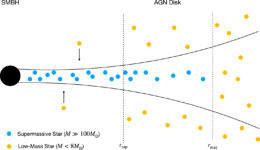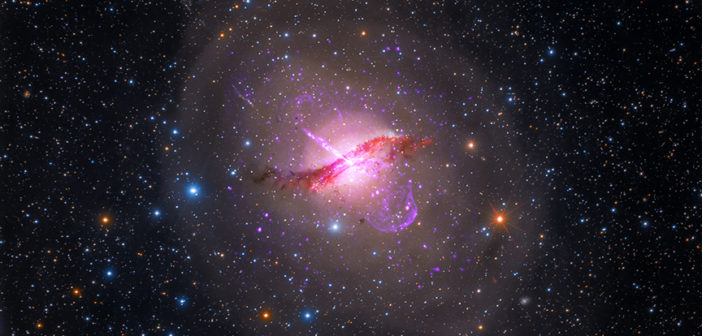Stars have been singing the same song since the beginning of the universe: you’re born, you fuse hydrogen into helium, you drift off the main sequence, and finally, you’re recycled into the cosmos. Under the right conditions, though, stars could become immortal. How is this possible, and what does it mean for these stars’ surroundings?
Live Fast, Die Never

Artist’s illustration of the surroundings of a supermassive black hole at the heart of an active galaxy. [ESO/M. Kornmesser]
As these stars churn hydrogen into helium in their cores, they constantly replenish their hydrogen stores from the surrounding disk. As a result, they never run out of fuel, never leave the main sequence, and never die. Now, a team led by Adam Jermyn (Flatiron Institute) has explored how these extreme stars might affect the evolution of the disk that surrounds them.

The disk around an active galactic nucleus (AGN) captures most stars within rcap. The stars within rmax grow and become immortal, while those outside the disk or beyond rmax accrete little gas. Click to enlarge. [Jermyn et al. 2022]
Drinking from the Stellar Fountain of Youth
Jermyn and collaborators considered disks with short (0.1 million years) and long (10 million year) lifetimes, estimating that these disks would capture 1,000 and 20,000 stars, respectively, from the inner regions of their galaxies. The short-lived disk only contains enough mass to raise 300 of these stars to immortality, while the long-lived disk can support all 20,000 stars.
In both disks, the immortal stars grow to 300 solar masses and have massive convective cores. The constant churning brings fresh hydrogen to their cores and transports helium outward to their surfaces. From there, fierce stellar winds carry the helium-rich gas out into the disk, boosting the abundance of helium near the black hole. The consequences of this chemical enhancement aren’t yet clear — it might rob immortal stars of their superpowers, since sucking up helium-rich material will make them burn through their hydrogen faster than it can be replenished — but measuring helium abundances in active galactic nuclei may provide a way to test the degree of chemical enrichment.
Immortal No More

This illustration shows that the gas in stellar winds feeds the disk in the innermost regions where the escape velocity is high and escapes from the disk in the outer regions, where the escape velocity is low. Click to enlarge. [Jermyn et al. 2022]
The authors note that their estimates are still uncertain, but it’s clear that immortal stars can play an important role in the evolution of the innermost regions of a galaxy. Future work might explore the consequences of helium-enriched gas spiraling around a supermassive black hole or assess the impacts of stars that form within the disk itself. Clearly, immortal stars provide plenty of work for modelers and observers alike — immortality might be beyond our reach, but at least we can live vicariously through these stars!
Citation
“Effects of an Immortal Stellar Population in AGN Disks,” Adam S. Jermyn et al 2022 ApJ 929 133. doi:10.3847/1538-4357/ac5d40
